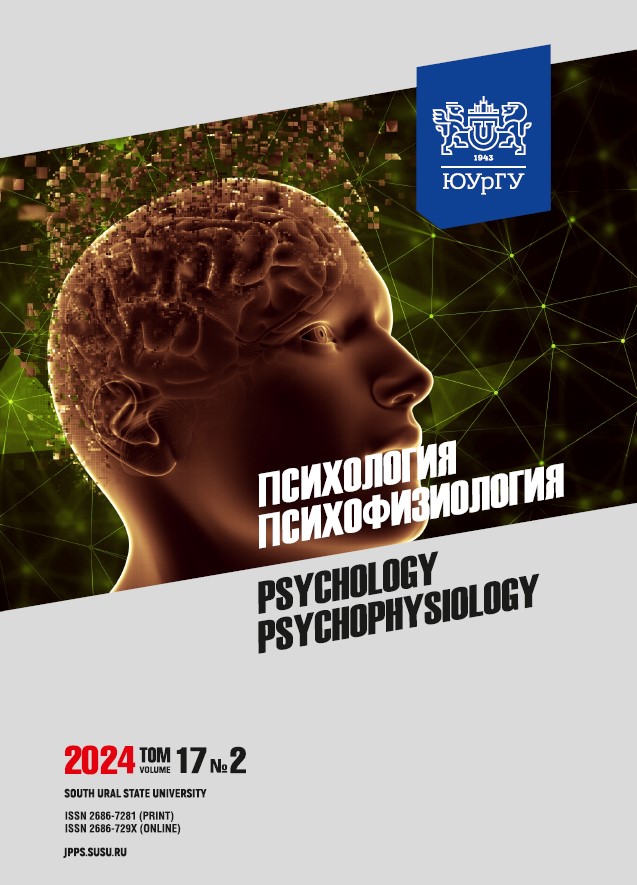Effectiveness of sensorimotor training in individual and competitive activity contexts for subjects in dyads
Abstract
Introduction. The exploration of psychophysiological and social determinants influencing the success of human activities is an urgent problem in neurosociobiology, particularly relevant given the tough requirements of many professions. Aims. This study aims to conduct a comparative analysis of sensorimotor test performance in individual versus competitive settings among the same subjects. Materials and methods. The study involved male volunteers recruited among students of the Moscow State Medical University of Medicine and Dentistry. Sensorimotor activity was simulated using the “Columns” exercise from the “BOS-Kinesis” software and hardware system (Neurotech LLC, Taganrog, Russia), incorporating biofeedback from the flexor muscles of the subjects’ dominant hand. The study was divided into two phases: individual training, where subjects were physically separated for task performance, and a competitive phase, where participants trained side-by-side, competing against each other. Data analysis was performed using GraphPad Prism v.6.01 and STATISTICA v.12 software packages. Results. The results obtained reveal that the impact of a competitive environment on sensorimotor activity varies significantly based on the subjects’ baseline individual performance. Notably, improvements in performance under competitive conditions were more pronounced among individuals who initially struggled with the task, whereas a considerable portion of those who had previously excelled saw a decline in performance. Conclusion. The study demonstrates individual typological features in how sensorimotor task performance changes under competitive conditions compared to individual efforts among male participants.
Downloads
References
2. Krishnan-Barman S., Forbes P.A.G., Hamilton A.F.C. How can the study of action kinematics inform our understanding of human social interaction? Neuropsychologia. 2017;105:101–110
3. Steixner-Kumar S., Rusch T., Doshi P., Spezio M., Gläscher J. Humans depart from optimal computational models of interactive decision-making during competition under partial information. Scientific Reports. 2022;12:289. DOI:10.1038/s41598-021-04272-x
4. Banks G.C., Whelpley C.E., Crawford E.R., OBoyle E.H., Kepes S. Getting along to get ahead: The role of social context in tournament promotion and reward systems. PLoSOne. 2021;16(9):e0257389. DOI: 10.1371/journal.pone.0257389
5. Dindar M., Ren L., Järvenoja H. An experimental study on the effects of gamified cooperation and competition on English vocabulary learning. British Journal ofEducational Technology. 2020;52. DOI:10.1111/bjet.12977
6. Ciobanu N.R., Barth K., Florescu M.C. Cooperation vs. Competition. Approaches on the inclusion of children with SEN. Különleges Bánásmód – Interdiszciplináris folyóirat. 2021;7:25–33. DOI: 10.18458/KB.2021.1.25
7. Triplett N. The Dynamogenic Factors in Pacemaking and Competition. American Journal of Psychology. 1898;9(4):507–533. DOI: 10.2307/1412188
8. Zajonc R.B., Heingartner A., Herman E.M. Social enhancement and impairment of performance in the cockroach. Journal ofPersonalityand Social Psychology. 1969;13(2):83–92. DOI: 10.1037/h0028063
9. Nijstad B.A., Stroebe W., Lodewijkx H.F.M. The illusion of group productivity: a reduction of failures explanation. European Journal of Social Psychology. 2006;36(1):31–48. DOI:10.1002/ejsp.295
10. Heinrich A., Koehler H., Müller F., Stoll O., Cañal-Bruland R. The impact of co-acting competitors on shooting performance in elite biathletes. Journal of sports sciences. 2022;40:1–9. DOI: 10.1080/02640414.2022.2127514
11. Li Y., Liu Z., Wang Y. et al. Spillover effects of competition outcome on future risky cooperation. Scientific Reports. 2023;13. DOI: 10.1038/s41598-023-32523-6
12. Cross L., Michael J., Wilsdon L. et al. Still want to help? Interpersonal coordinations effects on helping behaviour after a 24 hour delay. Acta Psychologica. 2020;206:103062. DOI: 10.1016/j.actpsy.2020.103062
13. Kaefer A., Chiviacowsky S. Cooperation enhances motor learning. Human Movement Science. 2022;85:102978. DOI: 10.1016/j.humov.2022.102978
14. Müller F., Cañal-Bruland R. Interindividual differences in incentive sensitivity moderate motivational effects of competition and cooperation on motor performance. PloSone. 2020;15:e0237607. DOI: 10.1371/journal.pone.0237607
15. Yang H., Duan Q., Peng M. et al. Sex differences on the response to others gains and losses under cooperation and competition. International Journal of Psychophysiology. 2022;182:211–219. DOI:10.1016/j.ijpsycho.2022.10.012
16. Klehe U.C., Anderson N., Hoefnagels E. Social Facilitation and Inhibition During Maximum Versus Typical Performance Situations. Tetrahedron Letters. 2007;20. DOI: 10.1080/08959280701333040
17. Sackett P.R., Zedeck S., Fogli L. Relations between measures of typical and maximum job performance. Journal of Applied Psychology.1988;73:482–486. DOI: 10.1037/0021-9010.73.3.482
18. Wagstaff G.F., Wheatcroft J., Cole J.C. et al. Some cognitive and neuropsychological aspects of social inhibition and facilitation. European Journal of Cognitive Psychology.2008;20(4):828–846.
DOI: 10.1080/09541440701469749
19. Lee M., Ahn H.S., Kwon S.K., Kim S. Cooperative and Competitive Contextual Effects on Social Cognitive and Empathic Neural Responses. Frontiers in Human Neuroscience.2018;12:218.
DOI: 10.3389/fnhum.2018.00218
20. Meskova E.S., Murtazina E.P., Ginzburg-Shik Yu.A. Joint action coordination: systemic aspects and sociopsychophysiological factors (review). Psikhologiya. Psikhofiziologiya = Psychology. Psychophysiology. 2022;15(3):91–102. (inRuss.). DOI: 10.14529/jpps220309
21. Wahn B., König P., Kingstone A. Interpersonal coordination in joint multiple object tracking. Journal of Experimental Psychology. Human Perception and Performance. 2021;47(9):1166–1181. DOI: 10.1037/xhp0000935
22. Kotovskaya S.V. Psychophysiological Factors of Professional Viability in Extreme Specialists from Emergent-Synergetic Perspective. Psikhologiya. Psikhofiziologiya = Psychology. Psychophysiology. 2020;13(1):79–87. (in Russ.). DOI: 10.14529/jpps200109
23. Mazikin I.M., Lapkin M.M., Akulina M.V., Kulagin P.A. Parameters of functional lateral organization of students of medical university with levels of physical fitness.Rossiiskiimediko-biologicheskiivestnikimeniakademika I.P. Pavlova = I.P. Pavlov Russian medical biological herald. 2022;30(3):367–374. (in Russ.). DOI: 10.17816/PAVLOVJ96768
24. Wongvorachan T. The Impact of Classroom Competition and Cooperation to Student Academic Performance. 2023. DOI:10.31234/osf.io/7vugd
25. Ouyang X., Liu Z., Gui C. The interactive effects of intragroup cooperation and competition: toward a perspective of paradox. ManagementDecision. 2023;61. DOI:10.1108/MD-11-2021-1462
References on translit
-Copyright (c) 2024 Psychology. Psychophysiology

This work is licensed under a Creative Commons Attribution-NonCommercial-NoDerivatives 4.0 International License.



